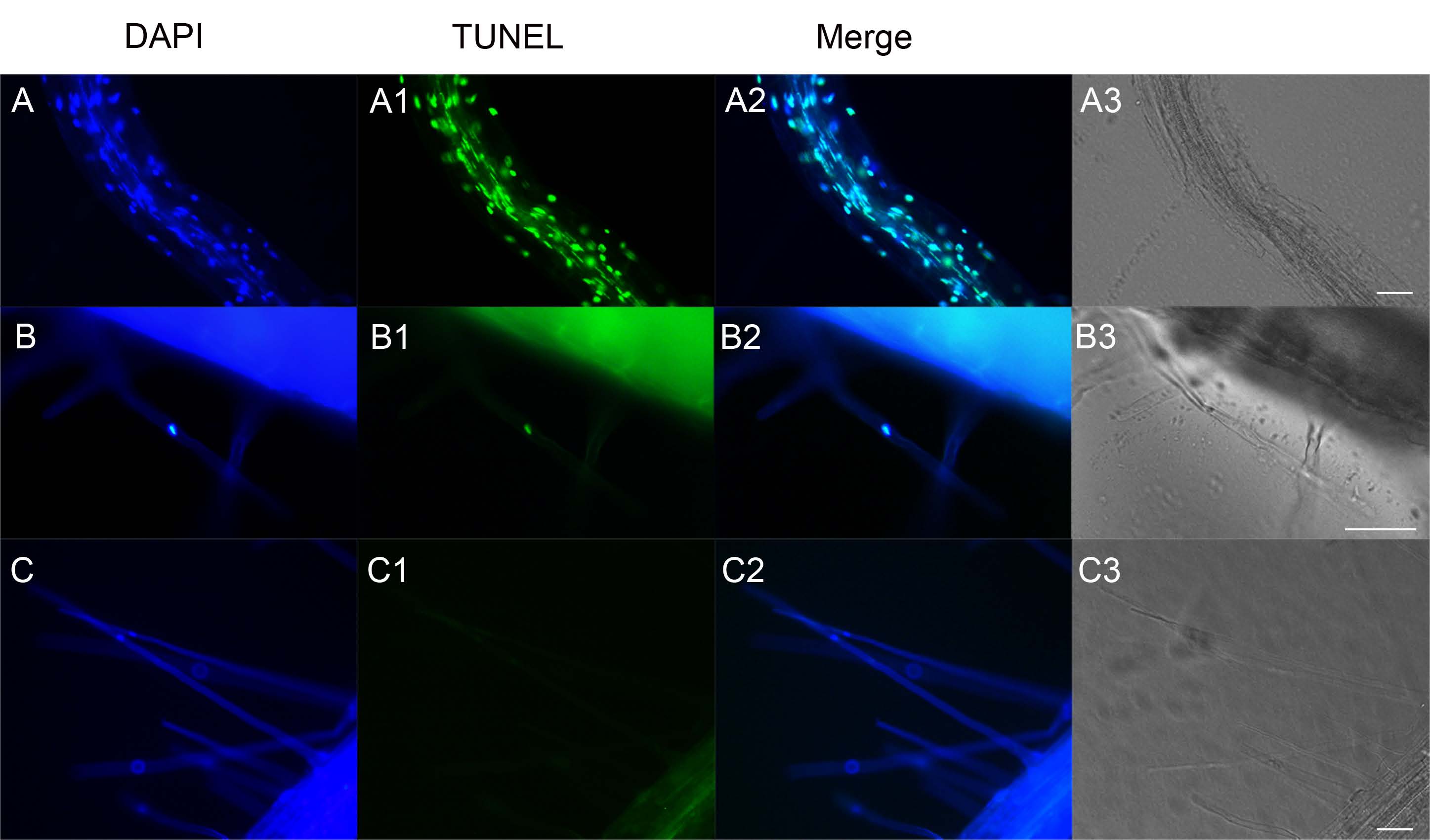

Characterization of Programmed Cell Death During the Senescence of Root Hairs in Arabidopsis
Received date: 2015-05-09
Accepted date: 2015-07-05
Online published: 2016-03-31
The root hair is an essential organ for the uptake of nutrients in plants; root hair cells can only survive for 2 to 3 weeks and then die off, but the mechanisms underlying root hair death is not clear. In this study, we investigated the cellular characteristics of root hair death. Arabidopsis dying root hairs underwent protoplast retraction from the cell wall, and some unknown aggregates were observed in the cell. On detecting DNA fragmentation by terminal deoxynucleotide transferase-mediated dUTP nick-end labeling (TUNEL), we found TUNEL-positive nuclei in root hairs. Protoplast retraction and nuclear DNA fragmentation are both considered hallmark features of apoptotic-like programmed cell death in plants. Therefore, we propose that the death of Arabidopsis root hairs belongs to programmed cell death, which is mediated by an intracellular program. As well, fluorescence staining with DAPI demonstrated that in dying root hairs, the nucleus would migrate to a position close to the basement of the root hair. Moreover, the tubular-shaped root hairs finally twist.

Key words: programmed cell death; root hairs
Lin Li , Kang Tan , Xiuguang Tang , Xiaoting Chao , Chenxi Wen , Zhuangdong Bai , Hualing Feng , Wenzhe Liu , Hui Su . Characterization of Programmed Cell Death During the Senescence of Root Hairs in Arabidopsis[J]. Chinese Bulletin of Botany, 2016 , 51(2) : 194 -201 . DOI: 10.11983/CBB15081
| [1] | 贺新强, 吴鸿 (2013). 植物发育性细胞程序死亡的发生机制. 植物学报 48, 357-370. |
| [2] | 李云霞, 程晓霞, 代小梅, 曾会明, 韩烈宝 (2009). 植物在逆境胁迫中的细胞程序性死亡. 生物技术通报 4, 711. |
| [3] | Delorme VG, McCabe PF, Kim DJ, Leaver CJ (2000). A matrix metalloproteinase gene is expressed at the boun- dary of senescence and programmed cell death in cucumber. Plant Physiol 123, 917-928. |
| [4] | Doyle SM, Diamond M, McCabe PF (2010). Chloroplast and reactive oxygen species involvement in apoptotic-like programmed cell death in Arabidopsis suspension cultures. J Exp Bot 61, 473-482. |
| [5] | Filonova LH, Bozhkov PV, Brukhin VB, Daniel G, Zhivo- tovsky B, Von Arnold S (2000). Two waves of program- med cell death occur during formation and development of somatic embryos in the gymnosperm, Norway spruce. J Cell Sci 113, 4399-4411. |
| [6] | Filonova LH, Von Arnold S, Daniel G, Bozhkov PV (2002). Programmed cell death eliminates all but one embryo in a polyembryonic plant seed. Cell Death Differ 9, 1057-1062. |
| [7] | Fukuda H (1997). Tracheary element differentiation. Plant Cell 9, 1147. |
| [8] | Grierson C, Schiefelbein J (2002). Root Hairs. Rockville, MD: American Society of Plant Biologists. pp. 1-22 |
| [9] | Groover A, Jones AM (1999). Tracheary element differentiation uses a novel mechanism coordinating programmed cell death and secondary cell wall synthesis. Plant Physiol 119, 375-384. |
| [10] | Gunawardena AH (2008). Programmed cell death and tissue remodelling in plants. J Exp Bot 59, 445-451. |
| [11] | Gunawardena AH, Greenwood JS, Dengler NG (2004). Programmed cell death remodels lace plant leaf shape during development. Plant Cell 16, 60-73. |
| [12] | Gunawardena AH, Pearce DM, Jackson MB, Hawes CR, Evans DE (2001). Characterisation of programmed cell death during aerenchyma formation induced by ethylene or hypoxia in roots of maize (Zea mays L.). Planta 212, 205-214. |
| [13] | Hogg BV, Kacprzyk J, Molony EM, O’Reilly C, Gallagher TF, Gallois P, McCabe PF (2011). An in vivo root hair assay for determining rates of apoptotic-like programmed cell death in plants. Plant Methods 7: 45. |
| [14] | Ketelaar T, Faivre-Moskalenko C, Esseling JJ, de Ruijter NC, Grierson CS, Dogterom M, Emons AMC (2002). Positioning of nuclei in Arabidopsis root hairs: an actin-regulated process of tip growth. Plant Cell 14, 2941-2955. |
| [15] | Li D, Yang X, Cui K, Li Z (2003). Morphological changes in nucellar cells undergoing programmed cell death (PCD) during pollen chamber formation in Ginkgo biloba. Acta Botanica Sinica 45, 53-63. |
| [16] | McCabe PF, Leaver CJ (2000). Programmed cell death in cell cultures. Plant Mol Biol 44, 359-368. |
| [17] | Miller DD, De Ruijter NC, Emons AMC (1997). From signal to form: aspects of the cytoskeleton-plasma membrane-cell wall continuum in root hair tips. J Exp Bot 48, 1881-1896. |
| [18] | Mittler R, Lam E (1995). In situ detection of nDNA fragmentation during the differentiation of tracheary elements in higher plants. Plant Physiol 108, 489-493. |
| [19] | Peterson RL, Farquhar ML (1996). Root hairs: specialized tubular cells extending root surface. Bot Rev 62, 1-40. |
| [20] | Reape TJ, McCabe PF (2010). Apoptotic-like regulation of programmed cell death in plants. Apoptosis 15, 249-256. |
| [21] | Shishkova S, Dubrovsky JG (2005). Developmental programmed cell death in primary roots of Sonoran desert Cactaceae. Am J Bot 92, 1590-1594. |
| [22] | Van Doorn WG (2011). Classes of programmed cell death in plants, compared to those in animals. J Exp Bot 62, 4749-4761. |
| [23] | Van Doorn WG, Woltering EJ (2005). Many ways to exit? Cell death categories in plants. Trends Plant Sci 10, 117-122. |
| [24] | Wang H, Li J, Bostock RM, Gilchrist DG (1996). Apoptosis: a functional paradigm for programmed plant cell death induced by a host-selective phytotoxin and invoked during development. Plant Cell 8, 375-391. |
| [25] | Zuppini A, Navazio L, Mariani P (2004). Endoplasmic reticulum stress-induced programmed cell death in soybean cells. J Cell Sci 117, 2591-2598. |
/
| 〈 |
|
〉 |